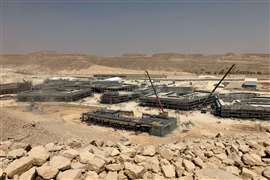Utilities: Gaining ground in new markets
11 April 2012

The technology behind installing utilities has developed in leaps and bounds over the last decade, and advancements continue all the time. From the latest keyhole innovations in horizontal directional drills (HDD) to innovative in-situ trench mixing processes, manufacturers are breaking new ground in terms of efficiency and environmental performance.
And while generalist methods such as digging trenches with excavators are still wide-spread, international demand for specialist equipment for utilities applications is increasing, according to manufacturers.
In terms of HDD, for instance, vice president of sales and marketing at American Augers, Dan Sharpe, said the popularity of trenchless techniques for installing underground utilities such as water pipes, fibre optic cables and gas pipes using a surface-launched drill rig, was growing every year in emerging markets.
Mr Sharpe reported rising demand in South America, Russia, India and China. "About 60% of our business comes from outside of the US, in Russia, China, the Middle East and South America," he said.
"Sales were high in 2011 - it was our best year since before the crisis. This year has also started with a very strong backlog, and we're expecting good growth throughout the year.
"Back in the 1980s, the drive to install fibre optic cables in developed countries fuelled the utilities market, but now the scale has been ramped up with a drive for larger water pipelines in developing countries, so larger drills are more in demand these days," Mr Sharpe explained.
In Latin America, for instance, Mr Sharpe highlighted a surge in demand for HDD equipment as people realised the benefits of not having to dig up roads.
"They don't want to tear up the environment or close roads, it causes a huge amount of disruption as there are often no bypass routes in these regions, so HDD is becoming the preferred choice. Time is also a factor, in rapidly developing countries, contractors have started to realise that a trenching project can take up to six months while an HDD installation can take just a month, and time is money in these situations. Also there is not the cost of reforming the trenches."
Mr Sharpe also said demand in North America was making a comeback. "In 2012 we expect to see a lot more business in the form of new shale gas pipelines and transmission and feeder lines. There are big projects in Pennsylvania and Ohio, and also in Canada, and this is really driving the utilities market forward in North America," he explained.
He added that American Augers would be releasing a rig later this year specifically designed for work in shale gas fields. The DD155 will be a smaller unit but with a very powerful torque, so that it can fit into confined spaces but still have high power.
Keyhole technology
Meanwhile, Tracto-Technik also reports increasing demand for directional drilling in utilities applications. The manufacturer said that new, keyhole technology was a particularly hot topic in the US, Europe and Australia at the moment.
"The idea is to install gas, water and glass-fibre house connections from the main line to the road out of the smallest possible bore hole, directly up to the house," the company explained in a statement.
Tracto-Technik has developed the steerable Grundopit K machine for these types of tasks, which it is currently testing on sites in Germany and internationally. The machine can be dry run or supported with drilling fluid, and has an average propulsion of 16 to 18 m/h.
"The idea for this development project came from Gas de France, which was searching for an economical method for house connections. The keyhole is circular and not larger than 650 mm. Firstly, a concrete or asphalt core is bored out of the ground with core bore unit above the main service line, then the suction excavator is applied, which sucks the keyhole free up to the main line, avoiding any damage.
"The Grundopit K can then be set up inside the keyhole and the real bore process can begin. The operation is carried out above ground. The bore head and drill rods are transported to the installation depth and aligned to the direction of the bore, and then each single drill rod is driven up to the building, just like any normal HDD bore," it said.
Tracto-Technik said usual bore lengths are approximately
20 m, and in the target area - the connection room of the building - the tool is then exchanged to allow protection piping and product piping to be pulled through the keyhole.
"After a couple of hours nobody would notice that anything has happened", Tracto-Technik said.
The advantages of the keyhole technology can also be seen in the US, where roads which have been renewed cannot be cut open again for five years, due to the follow-on damages and costs involved.
Here, the keyhole technique is allowed because the core can be put back in place after completion of the work without creating any addition asphalting costs, according to the company.
Meanwhile, specialist trenching machines which open up the ground to allow utilities to be laid, in contrast to the HDD method, are also available.
Fred Clarke, technical sales engineer at Mastenbroek reported increasing demand for the company's innovative new Trenchmix machines - specialist trenchers which mix native soil in-situ with a cement binder in the trench as the machine advances. This can be used for ground improvement, constructing a reinforced trench, or even building an impermeable cut-off wall.
Mr Clarke said, "We're quietly optimistic - the contractors are getting the work and there are some hot spots for business emerging, including activity relating to the renewable markets, cable laying etc., as well as gas transmission in Europe.
"Trenchmix is unique to Mastenbroek, and its great advantage is its efficiency. Actually the whole job can be cheaper with Trenchmix, particularly when considering things like logistics - contractors don't need to haul out any material, for instance. The product is gaining accreditation and acceptance in the market and demand is good in the Middle East and France, where we have recently supplied machines," Mr Clarke said.
Ditch Witch, too, is aiming to reach a wider market with its new range of walk-behind trenchers, which have been designed with small business owners, particularly equipment rental companies in mind.
The four model range - the RT12, RT16, RT20, and RT24 - have hydraulic systems, as opposed to belt-driven systems, featuring a stacked pump configuration that the company claims reduces downtime. The trenchers also have fully hydrostatic ground drives, with simple-to-use, hydraulic, skid-steer-style steering. The smallest trencher, the RT12, is powered by a 9 kW engine while the largest RT24 is powered by an 18 kW engine.
"Even novice operators can quickly understand the hand controls - one hand to mobile, two hands to trench - so there's less operator training necessary," Ditch Witch said.
Another company developing mini walk-behind trenchers is Little Beaver, which has modified its line of Kwik-Trench models - the KT200B and KT2400B. Featuring carbide-tipped teeth and a powerful drive system, the mini-trenchers are able to cut through tough surfaces such as compacted clay, road fill, asphalt and tree roots up to 10 in (254 mm) thick.
Both models can trench up to 30 ft (9 m) per minute and are designed to minimize backfill and clean up time by depositing soil beside the trench. Powered by a 5.5 hp (5 kW) Honda engine, the KT 200B is capable of producing trenches from 1 to 3 in (25 to 76 mm) wide and up to 8 in (203 mm) deep.
The KT 2400B is powered by an 8 hp (6 kW) Honda engine and can produce trenches between 1 and 4 in wide (25 to 102 mm) at a maximum depth of 12 in (305 mm).
Both Kwik-Trench models feature a compact design to allow easier access into tight areas unreachable to full-size trenchers. Little Beaver also offers an optional KT 2000 tilt bed utility trailer to make transportation of the mini trenchers easier.
Vacuum lifting
As well as trenchers and HDD technology, other specialist equipment often used for utilities applications include vacuum lifting technology for handing heavy piping, and there have also been recent developments in this field.
Vacuworx International has developed a new Vacuworx RC line of vacuum-lifting machines - the RC10, RC12, RC16 and RC20 models. Capable of lifting capacities ranging from 22000 lbs (10 tonnes) to 44000 lbs (20 tonnes), the machines use vacuum pads to lift and transport coated and non-coated pipe as well as steel, concrete, cast iron, glass and other materials.
Only the vacuum pad needs to be changed to accommodate different pipe diameters or other materials. The attachments can be used with a range of carriers, including excavators, cranes, wheeled loaders and tracked loaders.
Vacuum excavation is another specialist field. This technique involves removing earth from a hole using a powerful vacuum pipe, and is used to locate underground utilities. Using this method reduces the chance of striking a utility, which would be a risk with an excavator.
McLaughlin group has introduced a new heavy-duty steel arm to help carry the weight of its vacuum excavation hose and the debris being transported, reducing operator fatigue. The Strong Arm is a tank-mounted attachment which provides 200o of rotation and extends 6 ft (1.8 m) from the tank.
The attachment is currently available on all McLaughlin 500 and 800 gallon (1893 to 3028 litre) vacuum excavation machines.
Despite the availability of this specialist equipment, there is still huge demand around the world for general site equipment such as excavators, backhoe loaders and skid steers, which can also be turned to utilities applications.
Here, the versatility of attachments is growing in importance. A new Bobcat WS18 wheel saw mounted on a Bobcat S205H high flow skid-steer loader provided increased productivity for contractor Dogan Engineering on the Muscat International Airport Expansion Project in Oman, for example.
The WS18 was the first Bobcat wheel saw to be sold in Oman and was used to dig around 500 m of trenches for electrical and optical cables per shift per day (based on a 10 hour shift) in hard ground conditions.
Mustafa Turkmen, Project Manager for Dogan Engineering, said, "Initially we were using a Bobcat S130 skid-steer loader with the Bobcat LT313 trencher attachment, which we are still using elsewhere on the project. With its ability to work on this harder ground surface and the very high productivity it offers, the new wheel saw has opened up a new perspective on how best to implement jobs of this kind."
Manufacturers have also been working on increasing the versatility of couplers. JCB, for instance, has introduced two ranges of hydraulic hitches specifically designed to work with its JS excavator range and with the 3CX/4CX backhoe lines. Available as a factory-fit or an aftermarket option through JCB dealers, the Quickhitches are designed to ensure that the hitching process only functions when the excavator arm is in a safe position.
Each CE-certified Quickhitch is operated by a dedicated control system, which includes sensors on the machine's excavator arm. This ensures that the bucket or attachment is in a safe zone relative to the machine and to the ground, before the quickhitch can be operated.
And Piletec, a division of equipment hire specialist Groundforce, has also developed a unique adapter in partnership with Miller UK, designed specifically to allow the safe attachment of vibratory piling hammers to excavators via quick-hitch couplers.
Called Vibrosafe, the company said the device was conceived following a number of incidents in which quick-hitch failures and misuse by operators had, causing deaths and serious injury.
Piletec's aim was to produce an adapter which would eliminate the risk of human error by removing the need for the operator to manually insert locking pins or bolts after attaching the device to the quick-hitch.
The adapter was also designed to comply with manufacturers' recommendations and eliminate the risk of damage to the hammer's swivel assembly. It is also compatible with both semi-automatic and fully automatic hitches.
Growth prospects
Equipment aimed at the utilities market is becoming more and more refined, with efficiency savings and safety at the forefront of developments.
And with demand for water pipes, fibre optic cables and gas pipes set to continue to grow in developing countries, the use of specialist equipment that has been tailored to a specific task looks likely to continue to grow beyond the mature markets of North America and Europe.
STAY CONNECTED



Receive the information you need when you need it through our world-leading magazines, newsletters and daily briefings.
CONNECT WITH THE TEAM











